
Today's Coin Headlines

17 August 2008

It is with deep regret that I bid farewell to my very best friend in the coin world. Jack Lee passed away today.
24 September 2006

Michael, the morning after selling the last of his "Eliasberg" and "Wayne Miller" Morgan Dollars, all 11 of them. The price? Astronomical.
18 August 2006

Michael at the ANA's "World Fair of Money" this past August in Denver, Colorado
26 July 2006

Michael with longtime friend Jack Lee the all-time "King of Morgan Silver Dollars" at the "Baltimore Coin Convention" this past July
08 July 2006

Michael after a long walk in the woods....
17 October 2005
Colonial Americana
An extraordinary collection
Dealer and anonymous collector collaborate
Dan Freidus
Time, money, knowledge. Ah, we’d all be great collectors if we had enough of all three. A nice fantasy but most have limitations in one of the three (OK, let’s be realistic: more than one).
It’s how you cope with the limitation(s) and what tradeoffs you chose that define you as a collector.
I recently encountered a collector who’s made different choices than I have (and probably different than most numismatists) and it’s led to a very interesting collection.
I first found out about the "Stockbridge Collection" when some relatively highpriced Colonials started appearing on eBay recently. Not surprisingly, most didn’t sell.
Above a certain price point, collectors tend to want to see a Colonial in person or at least have someone they know look at it. I contacted the dealer listing these coins and then spoke with the collector.
You can see details of the collection at www.caspercoin.com, where the coins have been cataloged by Tom Rinaldo (a dealer specializing in Colonials who also catalogs McCawley & Grellman’s annual November Colonial auction, which you can find out about at www.colonialcoins.org).
Dealer Michael Casper told me that he had assembled this collection over the past year and a half for a client who had earlier collected Seated Liberty dimes by die variety and then high-grade Morgan dollars (the Amherst Collection). Casper is listing the entire collection (about 70 coins and about 120 pieces of Colonial and Continental paper money) for $600,000.
Don Kagin was also involved, inspecting and bidding on examples acquired at auction.
The coins are mostly a high-grade Colonial type collection while the paper money includes Continental currency and a full Colony set (plus Vermont), but is particularly strong in notes printed by Benjamin Franklin and engraved or printed by Paul Revere.
The collector turns out to be a physician with an entrepreneurial career in healthcare information and services. That 70-hourper-week career leaves him with more money than time for finding coins or numismatic research.
So he has collected with dealers doing much of the legwork for him. He’s enjoyed working with Casper, whom he described as a "gentlemen" with "extraordinary ethics."
Casper had only limited previous experience with Colonials (and an interest in the New York Excelsior coppers), but had to increase his knowledge on Colonials. Casper and the collector chose an unusual period to assemble this collection. Stack’s sales of the John J. Ford Jr. Collection has made the last few years not a once-in-alifetime but a once-in-a-century opportunity, since many of Ford’s coins were acquired privately from the estate of a collector who in turn had acquired entire collections virtually intact.
Therefore, literally hundreds of Ford’s coins had not been offered or seen publicly in a century.
Interest in Ford Colonials has made some other Colonials sell for strong prices. Colonials are getting more attention than usual at the same time that some Colonials are going for bargain prices while collectors hold back, expecting to spend their money in an upcoming Ford auction. (For example, one collector who sold some coins at auction in the fall of 2004 told me that he had some coins sell for half of his estimate while others sold for three times what he thought they were worth.) I was pleasantly surprised to find that the "Stockbridge" collector had attended the same small college from which I graduated. That only highlighted the different choices collectors can make. I’m glad to say that I don’t work 70 hours per week, but that’s one of the reasons I collect on a much more limited budget. But I’d be hardpressed to argue that the Stockbridge collector enjoys his collection any more or less than I enjoy my own. Different collectors, different coins, different choices.
We both started the way most collectors do: filling a penny board as a kid. I kept with it with only a few breaks while he collected only "sparsely" until a major surgery around the age of 50 made him keenly aware of his mortality.
This midlife event resulted in his evaluating his life and making deliberate choices to include certain activities he had been setting aside.
His re-entry into numismatics has been with fervor. In our discussion, it’s clear how much he’s enjoyed this episode, even if it’s with a combination of his money and someone else’s time that makes his collecting style somewhat uncommon.
Upon seeing the entire collection, he became ambivalent about his collection.
While he does expect to sell the currency, and has set a price for selling the coins with the notes, he’s now ambivalent about parting with the coins because he finds them so intriguing.
By the time you read this, the collector will have made a decision about whether to close the Stockbridge Collection chapter in his collecting or to make it even more spectacular by participating in Stack’s October sale of the Wurtzbach/Ford collection of Massachusetts silver coinage.
Dan Freidus is a collector and researcher specializing in early American numismatics. He can be contacted c/o Coin World, Box 150, Sidney, Ohio 45365, or by email at colonial.americana@umich.edu.
13 September 2005

The Stockbridge Collection of United States Colonial Coins and Currency that has been assembled here is remarkable for both its breadth and quality. Significant rarities and pieces of the highest possible quality are liberally represented in these holdings. Numismatic items which formerly graced other prestigious collections and sales are the norm in this Collection, not the exception. Specimens used for plates in some of the most popular and important numismatic reference works are not uncommon in these holdings.
With under 100 coins in total, the Stockbridge Collection is not and can not be as comprehensive a collection of the Colonial Coinage series as that assembled by Norweb or Ford, to name two obvious examples, as both of those collections featured many hundreds of issues. Yet many of the most important bases are covered, in the form of highly desirable high end examples of some of the most popular types sought after by today's collectors.
The Colonial and Continental Currency section is, if anything, even more impressive, and has at its heart a focus on the issues of two great early American patriots, Benjamin Franklin and Paul Revere. It is by no means exclusively a Franklin and Revere collection, however, containing as it does high quality issues from virtually every issuing colony or State of the relevant period, as well as a gorgeous sampling of Continental Currency notes. Still, it is the extensive offering of Franklin and Revere notes that captivates the spirit of the Stockbridge Collection, and for which it will be longest remembered.
It was an honor to gently handle all the wonders here gathered for the purpose of cataloging.
Tom Rinaldo, Cataloger Morgan Dollar dealer Michael Casper will be displaying the #1 Carson City Morgan Dollar PCGS Registry Set at the FUN Show, being held in Ft. Lauderdale, Florida, on January 13-16, 2005. The owner of the collection, Mike Gilley, who also assembled the #3 All Time Finest Morgan Dollar PCGS Registry Set, will also be present. This all-time-finest PCGS Carson City set can be viewed at Casper's table #1514 at the Greater Ft. Lauderdale/Broward County Convention Center. PHOTO LINKS: Gold, 20th century "modern" coins and silver dollars continue to lead the sizzling rare coin market as the final month of 2003 approaches with a rush. It's as though no one ever heard of a "December slowdown" or a "Christmas time fallback" or any of those other terms that used to explain the relatively quiet period around the holidays. "Morgan dollar enthusiasts, collectors and speculators are buying everything in sight," says Michael Casper, a silver dollar specialist from Ithaca, New York. "Most sales are in the $2,000 to $30,000 range, and it doesn't make any difference whether the coin is frosty Mint State or prooflike or DMPL. They'll take them all!" Are there any supply problems when you try to replenish your inventory? "I can't find quality Morgan dollars to buy for any amount of money," Casper said. "The last time I looked I had a total of 68 coins in inventory, and that included pieces from the Gilley collection and several other major collections plus my eBay auction and everything listed on my web site. That's one box of coins total. "I did buy one great coin in the last few days," Casper said, "but I had to go to another dealer's web site to do it. It's the Eliasberg 1891-CC in PCGS MS68PL. The coin cost nearly $100,000 but I had a customer who wanted it." Beauty. Rarity. History. Nostalgia. Popularity. Condition. Demand. Value. The "Magic 8" elements of a winning coin are manifested to the maximum in the deep mirror prooflike [DMPL] Morgan silver dollars of the Carson City Mint. There are only 13 dates in the set, but the collecting options expand from there depending on the collector's interest in die varieties. This article will explore the characteristics of each of these dates, along with their relative rarity in MS65DMPL or better condition. A great deal has been written in recent months about DMPL "CC" dollars being one of the hottest areas of the market. While this is certainly true, this doesn't mean that there is "renewed interest" in the series. Why not? Because the interest never went away during the previous decade. Even during the slowest periods of the sluggish 1990s a Gem-quality Carson City DMPL dollar was an easy sell to one of many eager buyers. These coins have everything, led by wild popularity and an ever-growing collector base. If you're familiar with the history of the Carson City Mint then you know about the discovery of the Comstock Lode, the "Crime of '73" and the subsequent political pressure from silver interests for a new silver dollar. Even though the denomination wasn't missed during the years when no silver dollars were issued (1874-77) the new design by George Morgan was put into production in 1878. Note: The prices quoted in this article are from the current PCGS Price Guide unless noted otherwise. The populations are from the January 2003 issue of "The PCGS Population Report." 1878-CC - This is one of the most popular of all the Carson City issues because of the first-year-of-issue status and the unusual "flat breast" reverse. This reverse is found on all 1878-CC dollars and a small quantity of 1880-CC dollars, plus some issues from other Mints. DMPL examples usually have three problems. One is die striations that interrupt the clarity of the mirrors. Two, there is usually a weakness of the strike around the claws and on the reverse wreath. Three, most pieces have numerous abrasions on the fields and devices. Gem (MS65 and better) DMPL pieces are even rarer than the population figures indicate because the coins don't come on the market with any regularity. There are only 35 examples certified in MS65DMPL or better. This coin lists in the PCGS Price Guide at $3,175 in MS65DMPL and will be priced between $3,000 and $6,000 on the bourse floors depending on the eye appeal, freshness, and overall aesthetics of the particular piece. 1879-CC - This is one of the great rarities of the series in MS65DMPL. In fact, there are only two coins certified in this grade, with nothing higher. The problem? Bagmarks! Carson City dollars are notorious for scuffs and scrapes, and the 1879-CC is one of the worst offenders. At times this date can be found with ultra-deep fields but the reflectivity is invariably impaired by numerous contact marks. The majority of the DMPL pieces located (a small number in any Mint State grade) are "frosty" DMPL, meaning that there is a light "shell" or coating of frost over the reflectivity. There is usually a slight softness to the central strike. This date lists at $7,700 in MS64DMPL but is not priced in MS65DMPL due to the extreme rarity. 1880-CC - This date is filled with die varieties that are highly significant to some collectors and virtually meaningless to others. In addition to numerous overdates from repunched 1879 obverse dies, there's also a pairing with the 1878-CC "flat breast" reverse. Even with all of the varieties added together there are only 42 pieces of this date in MS65DMPL or better. Depth of mirror ranges from frosty DMPL to ultra-deep crystal clarity, with cameo devices usually in evidence. This date lists at $3,175 in MS65DMPL, with bourse room prices ranging from $2,750 to well over $5,000 depending on the numerous factors that make up the overall aesthetics -- clarity of mirror, contrast, freshness, smoothness of Miss Liberty's cheek, the die variety, brilliance and so forth. 1881-CC - The so-called "common dates" of the Carson City DMPL issues are the coins from 1881 through 1885. The 1881-CC is the scarcest of those five dates, with a total of 160 pieces certified in MS65DMPL or better. This date is a delight to the eye, as it usually exhibits nice cameo contrast, a superb strike and excellent depth to the mirror fields. This coin lists at $1325 in MS65DMPL and $3225 in MS66DMPL. It is not uncommon to see prices that are 40% or so above those listed, even on a "wholesale" (or dealer-to-dealer) basis. 1882-CC - There are 254 pieces certified in MS65DMPL or better, including 48 pieces in MS66DM and even one in MS67DM. This is one of the prettiest issues, as there is often heavy cameo contrast against the mirror fields. One problem is strike, with many examples showing some weakness over the ear and on the breast feathers. The prices listed are $800 in MS65DM and $1,775 in MS66DMPL. Noted dollar specialist Mike Casper offered this observation on pricing Carson City dollars in MS65DMPL or better: "I usually figure the coins at 50% over greysheet [Coin Dealer Newsletter] ask when I buy them, so obviously the selling price is even higher than that. That is not for any piece, of course, but any of the examples that just beg you to buy them -- MS65+, MS66+ and so on -- are definitely worth that. Even with that kind of aggressive buying philosophy I can't keep them in stock. There's no such thing as an 'inventory' of Gem-quality CC DMPLs." 1883-CC - With a population of 543 pieces is MS65DMPL (or better) condition, this is the most common date of the series in Gem quality. Examples are usually well struck, but this date is also noted for softness in the central detail. At times the cameo contrast is heavy and the fields are crystal clear in their depth. Most DMPL pieces, though, are lightly frosted in the fields (as noted on the '79-CC and several other dates). Prices are listed at $675 in MS65DMPL and $3,150 in MS66DMPL. As is true with the other dates, the prices quoted on the bourse floors and in Coin World ads can vary greatly due to the overall eye appeal of the coin. 1884-CC - This is the second-most frequently encountered date in Gem-quality DMPL. There are 460 pieces certified in MS65DMPL or better, including 80 specimens in MS66DMPL (or better). This coin is somewhat unusual, as it frequently offers heavy cameo devices (pure snow!) against fields that barely meet the DMPL minimum standard. A highly attractive issue overall. Some specimens exhibit a weak reverse with measles-like white spots in clear evidence. This date lists at $550 in MS65DMPL and $3,000 in MS66DMPL. 1885-CC - This may be the prettiest of all the Carson City dollars. Deep mirror fields, medium-heavy cameo contrast, a superb strike and (at best) immaculate fields. Only 228,000 pieces were struck (that's less than the '89-CC) but the survival rate is relatively high. There are 195 pieces certified in MS65DMPL or better. The coin is listed at $1,500 in MS65DMPL and $3,750 in MS66DMPL. 1889-CC - This is the "king" of the Carson City dollars. While it is not the rarest date in DMPL, it is as rare as a coin can be in MS65DMPL or better, as there is still a zero in the Pop Report. The coin comes well struck, with deep mirrors and fair to excellent cameo contrast, but the main deterrent to a higher grade is contact marks. There are 18 pieces certified in MS64DMPL with a listed price of $62,500. One of the finest examples, pedigreed to the Wayne Miller collection, sold for $79,000. 1890-CC - This is the least popular date of the series. Why? Even though it is rare, the demand is somewhat subdued because the coin doesn't come "pretty." As a rule (but collectors welcome an exception!) there is minimal (or zero) contrast between the fields and devices and the best pieces barely meet the minimum standards for the grade. The are only 16 pieces certified in MS65DMPL with nothing higher. The current valuation is $9,800 in MS65DMPL, but it might be possible to purchase the coin for less. 1891-CC - The rarity of this coin sneaks up on you. There are more than 225 pieces certified as DMPL, but only one (!) is MS65DMPL, with zero higher. The amazing Eliasberg specimen realized over $120,000 and is in a PCGS MS68PL holder, but the coin didn't quite make it to the DMPL category. The problems include a weak central strike and lots of marks. The date lists at $2,375 in MS64DMPL. 1892-CC - Here's another tremendous condition rarity. Only two specimens have been certified in MS65DMPL with nothing higher. The MS64DMPL pieces usually show good reflectivity, a sharp strike and excellent cameo contrast. The drawbacks (as expected) are contact marks and, at times, poor central detail. There are a couple of controversial examples that have appeared on the market in recent years that are maybe-they-are-maybe-they-aren't Branch Mint Proofs. One piece is as convincing as any of the 1893-CC Proofs (in my opinion), but it is impaired by deep "slide marks" on the cheek. This date lists at $4,050 in MS64DMPL and one dealer reported a recent sale at $6,000. 1893-CC - This date is such a prohibitive rarity that there are zero examples in MS65DMPL or better. There are only seven pieces in DMPL in all grades combined, with nothing above MS64DMPL. Some of the "pancake strikes" of this date exhibit surfaces that are borderline DMPL, but crisp and fully struck examples are a great prize. There are two pieces graded in MS65PL; Mike Casper sold one for $105,000 as part of a complete set. Michael Casper Collection sells for over $1.7 million. The Morgan dollar collection that is listed as #3 of all time on the PCGS Set Registry has traded hands. Michael Casper, a dealer/collector from Ithaca, New York, assembled the set over several years and sold it in recent days for over $1.7 million. "The set was complete except for about 20 coins, most of which were sold at auction late last year. There were also about $200,000 worth of duplicates that were included in the sale," Casper said. "The buyer was a Texas collector who appreciates fine art and significant historical artifacts. This is his first venture into numismatics." Casper's set included many items that are pedigreed to the finest Morgan dollar sets ever assembled. Below are some of the highlights of the set, their pedigrees and the prices that they just traded for. Last month, I was set up at the Baltimore Show and, as usual, did more buying than selling. Just after I set up my table, I wanted to run and see what was on the floor. When I got to Jack Lee's table, he flashed me a big smile and said he had just bought Andy Hanson's Morgan Dollar set (which was 98% complete and ranked in the Top Two). I asked him how much and that smile just got bigger. "$3.5 million," was his reply. I guess you could call that a first-hand rumor.
Anyway, Jack told me he had already sold about a third of the coins to one collector and two other dealers, so I was the fourth person to get to pick through the coins. Jack told me he has plans to complete another set . . . higher than his first. What a feat that will be !! I did manage to buy an 1881-S in MS69 during my pit stop at Jack's. And shure 'nuff, I found one of the other dealers that Jack had sold some of them there Morgans to and managed to snag an Eliasberg 1887-O, and 1880-S in PCGS MS68PL and I'm still negotiating for a 1894-O wonder coin!
So it looks like Jack Lee is the lead dog once again! Oh! I forgot to mention . . . it was Jack Lee who wound up with that 1893-S out of THAT New York City auction. It was a raw coin . . . definitely an MS67, with a possible shot at 68 (in my book). He said he paid "four hundred some odd grand" for it and and told me that he turned down $900,000 for it. After I looked at it again, I don't blame him . . . as it's a million dollar coin . . . all day long!
The second highest Morgan set out there now belongs to a real estate developer on the East Coast and I know of a few other high end sets that are being put together in the Western United States.
Looking back over the past coupla months, I have personally a) moved several hundred thousand dollars worth of Morgans; b) downright refused to sell several hundred thousand dollars more ('cause people wouldn't meet my price); and c) watched over $1 million worth of Morgans change hands on the Baltimore floor in less than two hours !! When you got nice Morgans for sale and somebody has to fill "that space", they do go quickly.
xoxoxo, Michael
The Santa Clara show (November 15-18) featured a Heritage Numismatic Auctions "Signature Sale" that offered 44 select pieces from the Michael Casper collection of Morgan dollars. Here are some of the notable prices realized: When it comes to great silver dollars the last two years have been a bonanza for collectors. The famed NFL set of Morgan dollars was sold recently, as was the finest set of Peace dollars. In November we'll see the Flannagan set of Bust dollars offered by Bowers & Merena Galleries as well as part one of the Mike Casper Morgan dollar set, which is being sold by Heritage Rare Coin Auctions of Dallas, Texas.
Forty-four of the coins from Casper's collection will be sold November 16, 2001 in conjunction with the Santa Clara show. Why only 44? "To be honest, I love the coins so much that I couldn't bear to part with all of them at one time," Casper said. Part two of the collection will be offered by Heritage at the FUN show in January of 2002.
Of the 44 coins offered in the first part, ten are the finest graded or tied for the finest graded. "Every coin in my set is PCGS-certified," Casper said. "In this first part I chose coins in all price ranges, from the inexpensive to some of the ultra-rarities." Bruce Amspacher has been a professional writer since the 1950s and a professional numismatist since the 1960s. He won the OIPA sportswriting award in 1958 and again in 1959, then spent eight years in college studying American Literature. This background somehow led him to become a professional numismatist in 1968. Since then he has published hundreds of articles on rare coins in dozens of publications as well as publishing his own newsletter, the “Bruce Amspacher Investment Report,” for more than a decade. His areas of expertise include Liberty Seated dollars, Morgan and Peace dollars, United States gold coins, sports trivia, Western history, modern literature and the poetry of Emily Dickinson. In 1986 he was a co-founder of the Professional Coin Grading Service (PCGS). Today he is a full-time writer for Collectors Universe. My life has been forever changed. The security that we once knew is no more. A moment of silence, please, for those who have died, for those who have lost loved ones and for those who suffer.
On a personal level, my prayers go out to my friend and teacher Tom Brown, Jr., whose brother-in-law, Michael Horrocks, was the pilot of United Airlines flight #175. ATLANTA ANA - MID TO HIGH END MORGAN DOLLARS I arrived in Atlanta early Sunday morning, 5 August, and wasn't surprised to hear that I had missed little to nothing with regard to high end Morgan dollars by not attending the pre-ANA Show.
The Colonial Coin Collectors Club.
29 December 2004
From the PCGS.com Website
Top-ranked Carson City Morgan Dollar Set to be Displayed at FUN Show

Click to article on PCGS.com
13 March 2004
Baltimore Show March 04
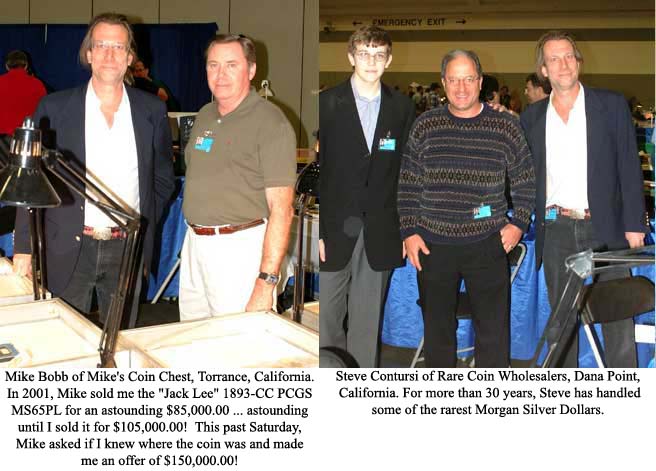

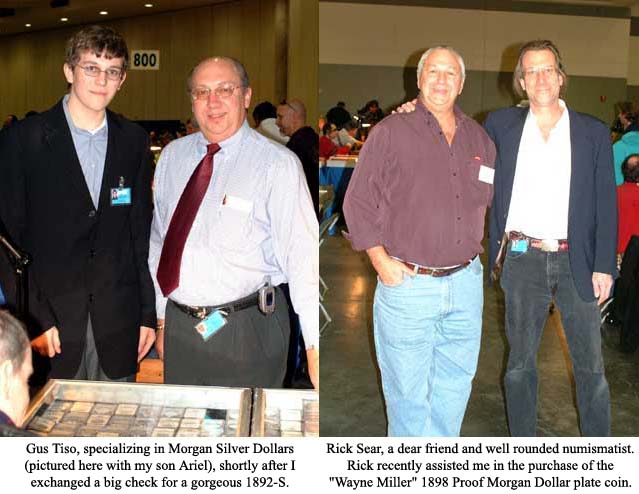
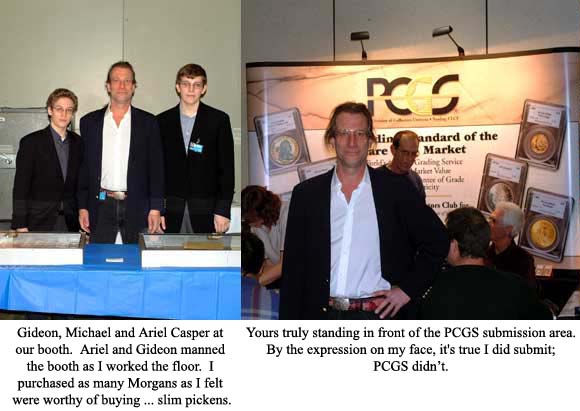
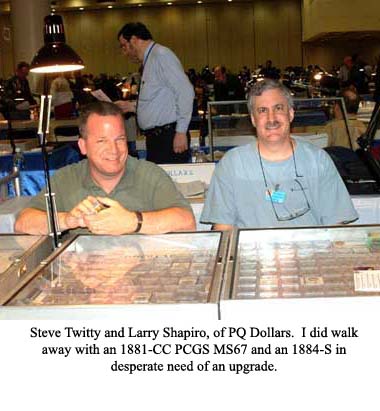
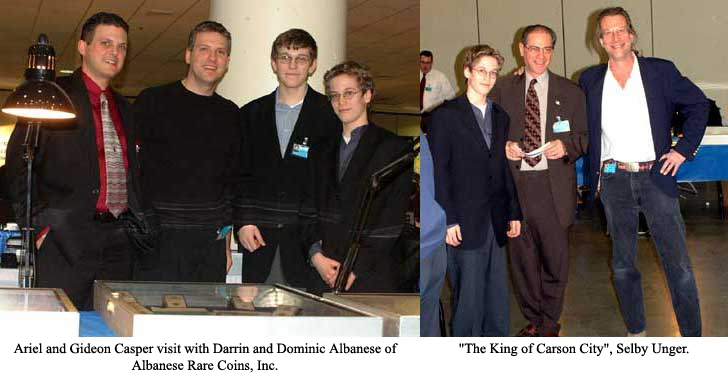
4 Febuary 2004
My first complete set of Morgan Dollars sold in April of 2002 and, at the time, was the 3rd finest set ever assembled. I'm still working with the current owner to upgrade and enhance it. Since that sale almost two years ago, I have focused my energies on the completion of another set. Currently comprised of almost 150 coins, the Mike Casper II Set is what I would describe as "upper mid-range" ... in other words, a Morgan Dollar set that costs under one million dollars with a grade point average above MS65.
SOLD
31 January 2004
Photographs from the annual Florida United Numismatists (FUN) Show, held the first week of January each year in Orlando, Florida and the annual dinner of the National Silver Dollar Round Table. 


25 November 2003 - Bruce Amspacher
Morgan dollar entusiasts are ''buying everything in sight.''
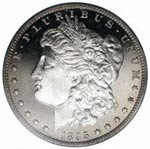
Bruce Amspacher has been a professional writer since the 1950s and a professional numismatist since the 1960s. He won the OIPA sportswriting award in 1958 and again in 1959, then spent eight years in college studying American Literature. This background somehow led him to become a professional numismatist in 1968. Since then he has published hundreds of articles on rare coins in dozens of publications as well as publishing his own newsletter, the “Bruce Amspacher Investment Report,” for more than a decade. His areas of expertise include Liberty Seated dollars, Morgan and Peace dollars, United States gold coins, sports trivia, Western history, modern literature and the poetry of Emily Dickinson. In 1986 he was a co-founder of the Professional Coin Grading Service (PCGS). Today he is a full-time writer for Collectors Universe.
14 January 2003 - Bruce Amspacher
Bruce Amspacher has been a professional writer since the 1950s and a professional numismatist since the 1960s. He won the OIPA sportswriting award in 1958 and again in 1959, then spent eight years in college studying American Literature. This background somehow led him to become a professional numismatist in 1968. Since then he has published hundreds of articles on rare coins in dozens of publications as well as publishing his own newsletter, the “Bruce Amspacher Investment Report,” for more than a decade. His areas of expertise include Liberty Seated dollars, Morgan and Peace dollars, United States gold coins, sports trivia, Western history, modern literature and the poetry of Emily Dickinson. In 1986 he was a co-founder of the Professional Coin Grading Service (PCGS). Today he is a full-time writer for Collectors Universe.
23 April 2002 - Bruce Amspacher
1878-8TF
PCGS MS66/PCGS Tour
$13,500
1879-CC
PCGS MS65PL
$20,000
1881-O
PCGS MS65/PCGS Tour
$5,850
1881-S
PCGS MS69
$38,000
1883-O
PCGS MS67/Bodway, Lee [Collections]
$6,700
1884
PCGS MS67/Gauya, Bodway, Lee, NFL
$12,000
1884-S
PCGS MS63/Wayne Miller
$30,000
1886-O
PCGS MS65/Eliasberg
$150,000
1886-S
PCGS MS67/PCGS Tour/Lee
$31,500
1887-O
PCGS MS66PL
$45,000
1892-S
PCGS MS67/Eliasberg
$150,000
1892-CC
PCGS MS66/PCGS Tour
$28,500
1893-O
PCGS MS64/Wayne Miller
$20,000
1893-CC
PCGS MS65PL
$100,000
1896-O
PCGS MS64
$45,000
1897-O
PCGS MS66/Eliasberg
$52,000
1901-S
PCGS MS66
$14,000
Bruce Amspacher has been a professional writer since the 1950s and a professional numismatist since the 1960s. He won the OIPA sportswriting award in 1958 and again in 1959, then spent eight years in college studying American Literature. This background somehow led him to become a professional numismatist in 1968. Since then he has published hundreds of articles on rare coins in dozens of publications as well as publishing his own newsletter, the “Bruce Amspacher Investment Report,” for more than a decade. His areas of expertise include Liberty Seated dollars, Morgan and Peace dollars, United States gold coins, sports trivia, Western history, modern literature and the poetry of Emily Dickinson. In 1986 he was a co-founder of the Professional Coin Grading Service (PCGS). Today he is a full-time writer for Collectors Universe.
18 March 2002
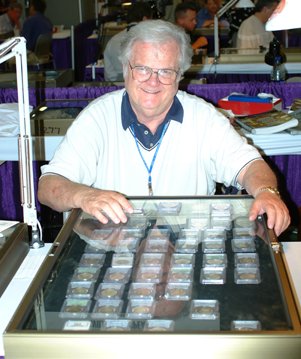 In Memory of BILL SPEARS, a good friend and the most famous Morgan Dollar dealer of all time...
In Memory of BILL SPEARS, a good friend and the most famous Morgan Dollar dealer of all time...
17 December 2001
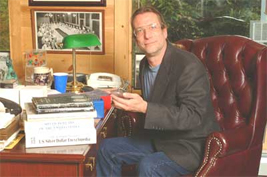 In August of 2001, I completed my Morgan Dollar set which now ranks in Third Place in the PCGS "All-Time Finest" Morgan Dollar Sets.
In August of 2001, I completed my Morgan Dollar set which now ranks in Third Place in the PCGS "All-Time Finest" Morgan Dollar Sets.
20 November 2001 - Bruce Amspacher
1880 Morgan Dollar
PCGS MS66
$6,670
1884 Morgan Dollar
PCGS MS65DMPL
$2,415
1885-O Morgan Dollar
PCGS MS67
$3,450
1888-O Morgan Dollar
PCGS MS65DMPL
$2,300
1890-CC Morgan Dollar
PCGS MS66
$13,800
1899-S Morgan Dollar
PCGS MS66
$3,450
1904 Morgan Dollar
PCGS MS65
$4,141
Bruce Amspacher has been a professional writer since the 1950s and a professional numismatist since the 1960s. He won the OIPA sportswriting award in 1958 and again in 1959, then spent eight years in college studying American Literature. This background somehow led him to become a professional numismatist in 1968. Since then he has published hundreds of articles on rare coins in dozens of publications as well as publishing his own newsletter, the “Bruce Amspacher Investment Report,” for more than a decade. His areas of expertise include Liberty Seated dollars, Morgan and Peace dollars, United States gold coins, sports trivia, Western history, modern literature and the poetry of Emily Dickinson. In 1986 he was a co-founder of the Professional Coin Grading Service (PCGS). Today he is a full-time writer for Collectors Universe.
6 November 2001 - Bruce Amspacher
11 September 2001
![]() Auction for America
Auction for America
14 August 2001
Mike Casper's Opinion www.caspercoin.com
On Monday morning, I took my time going through the 200+ lots of Morgans that were being offered by Heritage in their Signature Sale that would be held later in the week. It didn't take me very long to recognize several specimens that had my name on them! (The 79-CC PCGS MS65PL literally does have my name on it now.) Set up for PNG dealers began at 5:00 p.m., and things started to heat up from there.
Tuesday morning, I found a 30 odd lot of toned Morgans from Wayne Miller's textbook. That's right! The color plate coins! All of them were common date Morgans in MS63 - MS65 and the asking price was $25,000. Now get this -- grey sheet ask on all these coins was around $3,000. The toning was okay and I give the lot a rating of about 6 out of 10, which translates to about $3,500 - $4,000. I said to myself, "I'll wait a day and go back and pick it up for ten grand." I did exactly that . . . and guess what? The lot was gone for $25,000!! I did manage to snag Wayne Miller's 93-O in PCGS MS64, an Eliasberg 85-O in PCGS MS64DMPL (possible branch mint proof) and the Eliasberg 1900-S in PCGS MS66.
As I was signing a five-digit check for an 86-S in PCGS MS66, a 91-S in PCGS MS65, an 87-O in PCGS MS65 and an 84-CC in PCGS MS67PL, I looked up and guess who was coming down the aisle? None other than the legendary Jack Lee! He was accompanied by former Houston Oilers middle linebacker Gregg Bingham (Jack had the all time finest Morgan set and Gregg had the fifth). I didn't know which way to run! Should I be polite and say, "Howdy" or should I head in the other direction before those two guys get some of the goodies away from me??? Jack had a big smile on his face and Gregg let me take a peek at some of the most outrageously toned monster quarters, commems and Morgans that you'd ever want to see. He had one toned Morgan puppy that I labeled "The Electric Rainbow Wonder Coin"!
I picked up several choice semi key date Morgans from John Love and they never made it back to my table! Boom! They were gone. Some fellow asked what I found and when I showed him, he made me an offer I couldn't refuse.
Later in the day,
the highest graded Carson City Morgan dollar set
traded hands. This set was comprised of a 78-CC in 67, a 79-CC in 66, an 80-CC in 67, an 89-CC in 65, a 90-CC in 66, a 91-CC in 67, a 92-CC in 67, a 93-CC in 65 and the rest, to the best of my knowledge, were all 68s! The price was almost three-quarters of a million dollars!
It appears that there is a battle going on in the Morgan arena for current first place. The alleged grade point average of these top two sets is somewhere between 66.59 and 66.63, at a cost somewhere between $3.5 and $5.5 million.
A highlight for me in Atlanta was unveiling, for the first time, my Morgan dollar set which is now the undisputed third finest set in existence. There were a half dozen or more collectors who expressed serious interest in obtaining some part of my set. As I told everyone, the set is for sale; however, at this time, it is being offered only in its entirety. At present, I am considering offers of over $2 million.
Now get this! All of the above three sets are allegedly missing the 1893-S. I, for one, have only come across three in the past year. One was not worth looking at, the second I got rid of like a hot potato and the other has an asking price of three times grey sheet bid.
As for sales, ALL of my choice material was gone within three hours. The key here is "choice". Remember, folks, buy the coin, not the holder. A high end 5 might be worth more than a low end 6. And a high end 6 is almost always worth more than a low end 7, in my opinion, of course.
Bottom line: It is my belief that the Morgan dollar market has not been healthier in years. Most dealers, collectors and speculators are HOLDING tight and waiting for the market to rise. All we need is for two or three collectors to walk in and attempt to build a high end, low pop set . . . and it'll be party time.
Atlanta ANA 2001 was my best show ever!
Morgan Dollars | The Stockbridge Collection of Colonial Coin & Currency | US Type | Coins We've Sold
Collection Building | Consignment | Consulting | Appraisal | Auction Representation | Want List | Services
About Michael | Recent News | Professional Affiliations | Contact
